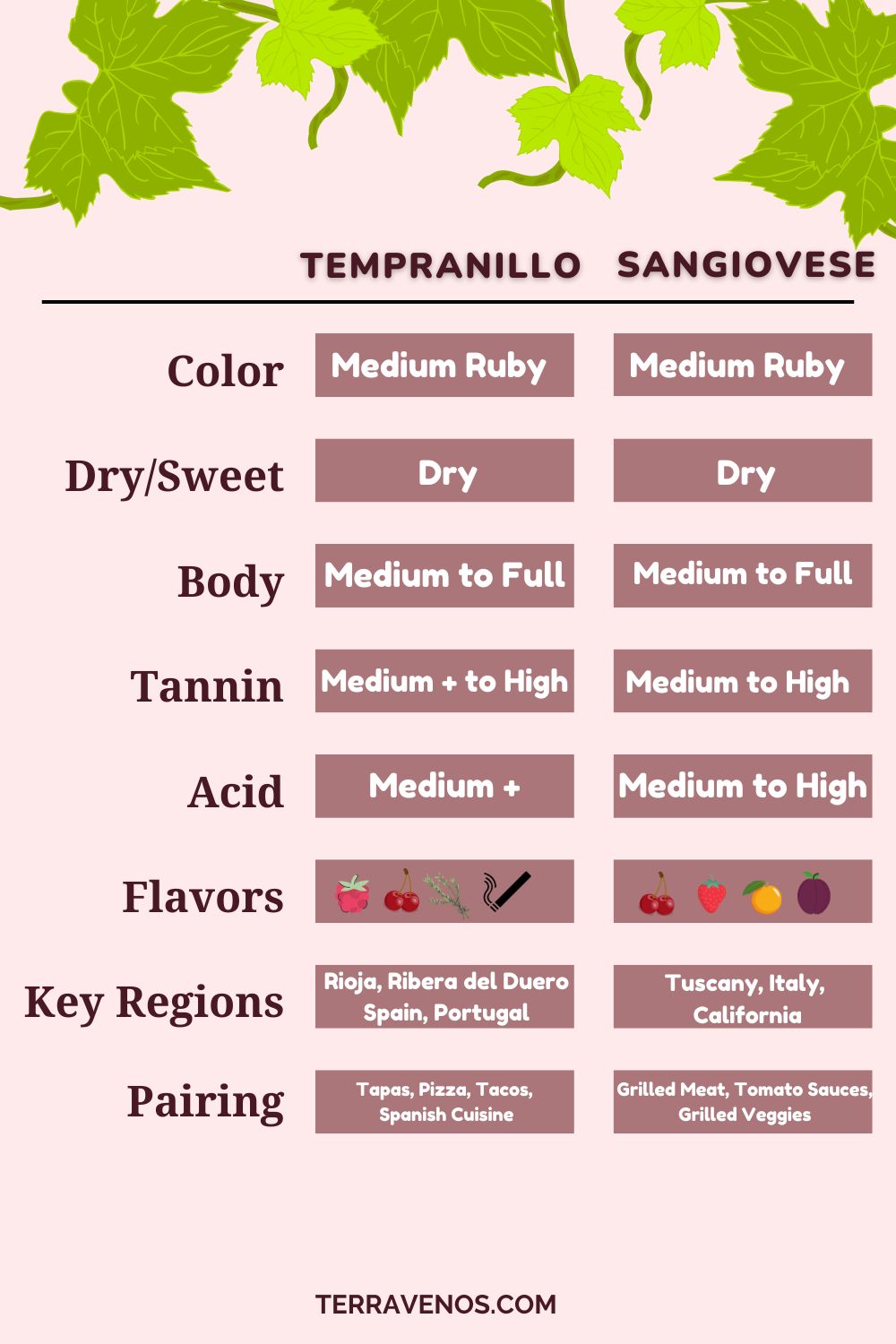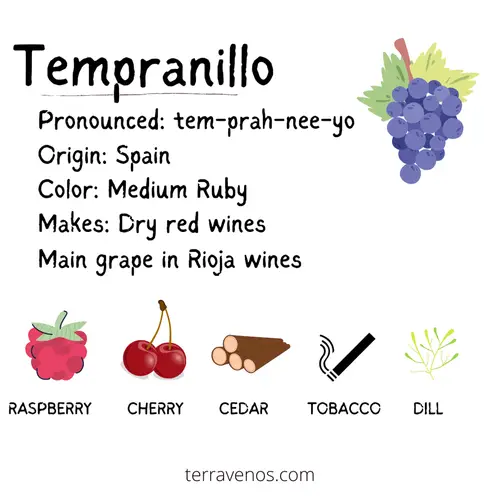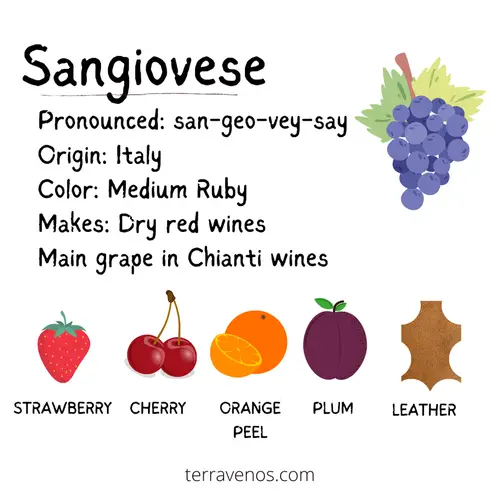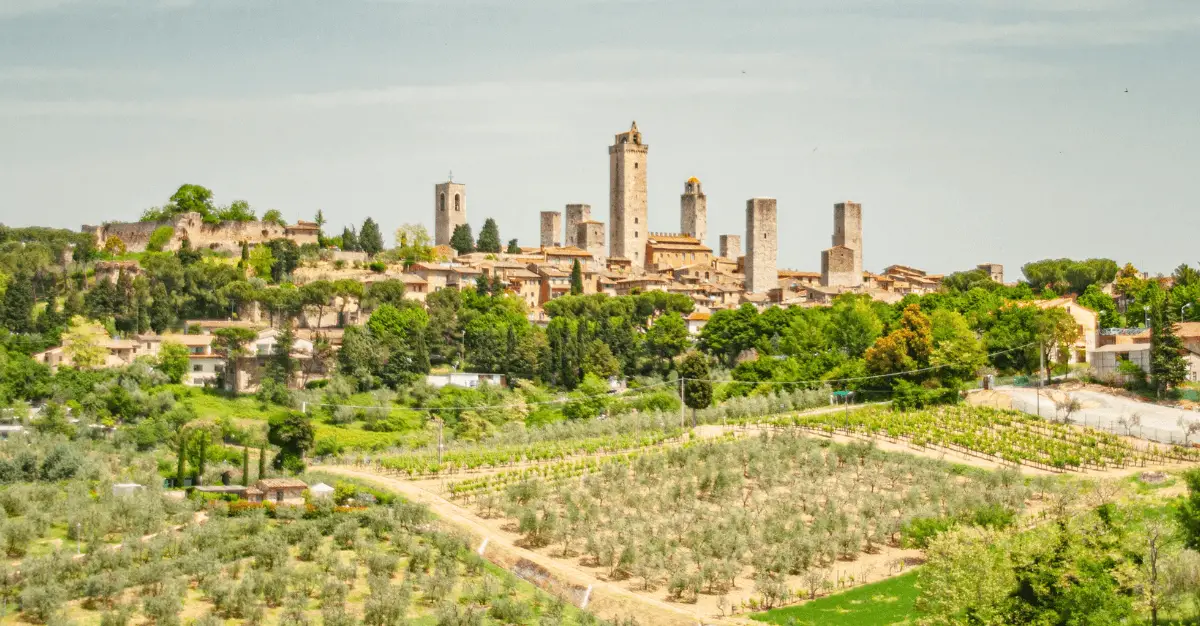
If you’re comparing Tempranillo vs Sangiovese, you’ve discovered two bright food-friendly wines.
Tempranillo and Sangiovese have similar tannin, alcohol, and body. Sangiovese has higher acid with earthy aromas. Tempranillo has savory notes.
Comparing Tempranillo vs Sangiovese is a perfect way to learn about these two common red wines.
Tempranillo Basics: Spain’s Red Wine

Tempranillo, a well-regarded grape originating from Spain, has gained worldwide recognition for its robust character. Now a global favorite, Tempranillo thrives in vineyards worldwide, from Spain’s Rioja and Ribera del Duero to New World regions.
With its deep crimson color, Tempranillo offers a palate of red berries complemented by subtle hints of coconut, herb, and cedar. This flavorful profile has made it popular among wine enthusiasts globally, securing its place in cellars.
Spain, the birthplace of Tempranillo, showcases its versatility from everyday wines to prestigious reserva and gran reserva selections.
Fun Wine Fact: Tempranillo gets its name from the Spanish word “temprano,” meaning early, as it usually ripens before many other grape varieties.
Helpful Tip: Here’s a complete guide to Tempranillo.

Sangiovese: Italy’s Workhorse

Sangiovese, an ancient Italian grape, plays a significant role in the country’s wine culture. This food-friendly red wine has a medium to full body with red fruit notes, such as cherries and raspberries, complemented by subtle herbal. Italy remains the primary producer of Sangiovese globally, offering a diverse range of options to cater to various tastes and budgets, from everyday drinking wines to premium selections.
You’ll also find excellent Sangiovese expressions from regions like California. Here’s a full post on Sangiovese.
Fun Wine Fact: Sangiovese is a primary grape variety in the world-renowned Chianti wine. Check out this post on how to buy Chianti wines, along with a print-out shopping guide.
Wine Comparison: Tempranillo vs Sangiovese
Here’s a quick side-by-side comparison that covers the most common styles of Tempranillo and Sangiovese:
| Characteristics | Tempranillo | Sangiovese |
|---|---|---|
| Hue | Deep ruby to garnet | Ruby to garnet |
| Color | Red | Red |
| Aromas | Red berries, plum, tomato, coconut | Cherry, violet, earthy |
| Tannins | Moderate to high | Moderate to high |
| Acid | Moderate | Moderate to high |
| Alcohol (%) | 13-15% | 13-15% |
| Body | Medium to full | Medium to full |
| Intensity | Moderate to pronounced | Moderate to pronounced |
| Key Growing Regions | Spain (Rioja), Argentina, Portugal | Italy (Tuscany), California |
| Classic Pairings | Grilled meats, chorizo, tapas | Pasta, pizza, grilled meats |
| Price Range | $10-$50 | $10-$60 |
Tempranillo Wine Profile
- Sweetness: Tempranillo is typically produced in a dry style, offering minimal residual sugar.
- Alcohol: Tempranillo wines generally have a low to moderate alcohol content, ranging from around 12% to 14% ABV.
- Body: Known for its medium to full body, the style of Tempranillo will depend on the growing region and winemaker.
- Tannins: Tempranillo has medium + to high tannins, similar to Sangiovese.
- Flavor and Aroma Intensity: Tempranillo has juicy red fruit, including cherry, plum, and tomato (tomato leaf); aged Tempranillo can get savory leather notes
- Flavors: The flavor profile often includes red cherry, strawberry, and raspberry, with a touch of coconut and spices.
Sangiovese Wine Profile
- Sweetness: Sangiovese is typically produced in a dry style, offering minimal residual sugar.
- Alcohol: Sangiovese wines generally have a moderate alcohol content, ranging from around 13% to 14.5% ABV.
- Body: Sangiovese has a medium body. You may come across fuller-bodied expressions in premium Sangiovese wines.
- Acid: Sangiovese has medium plus acidity. This higher acid level makes the red fruit taste bright and fresh.
- Tannin: Medium and textured. In cooler years, if the grapes don’t fully ripen, this can add herbal notes to your Sangiovese wine.
- Flavor and Aroma Intensity: Sangiovese boasts vibrant aroma intensity, with red cherries, raspberries, and hints of herbs and earthiness.
- Flavors: The flavor profile often includes notes of red berries, subtle spice, herbal undertones, and sometimes an orange peel.
Helpful Tip: If you’re unsure about serving temperatures, here’s a breakdown of wine serving temperatures for different wine styles and occasions.
Are Tempranillo and Sangiovese Similar?
Both Tempranillo and are medium to full bodied red wines with medium plus to high tannins, and higher acid levels. They both showcase bright red fruit. Both Tempranillo and Sangiovese are often used in regional blends: Tempranillo goes into Rioja, and Sangiovese goes into Chianti.
What Is the Difference Between Tempranillo and Sangiovese?
Tempranillo has a savory quality with tomato leaf. Sangiovese has notes of orange peel or pith, along with earthy undertones.
Tempranillo vs. Sangiovese: Food Pairings and Serving Temperature

Tempranillo: Tempranillo’s bright red fruit profile makes it an excellent pairing partner for earthy dishes, like lentil soup and paella. Check out: Tempranillo Food Pairing Guide
Sangiovese’s medium body and higher acidity make it a perfect match for classic Italian dishes, including pasta with tomato-based sauces, grilled meats, and aged cheeses.
Both Tempranillo and Sangiovese are best enjoyed at a slightly cool temperature. Place them in the refrigerator for about 10-15 minutes before serving.
Discover More:
Red Wine and Cheese Pairing: What You Need to Know
Tempranillo Cheese Pairing Guide
Sangiovese Food Pairing Guide
Which Is More Expensive, Sangiovese vs Tempranillo?

The price you pay for a bottle of wine will depend on various factors. In general, Sangiovese and Tempranillo wines are similarly priced. You should be able to find decent bottles of both wines within any wine budget.
Helpful Tip: Here’s how a bottle of wine gets priced. This post is a little nerdy, but it’s quite complicated and nuanced depending on where you are in the world and where you’re buying your wine.
Tempranillo Cost
Entry-level Tempranillo wines are typically affordable, ranging from $8 to $10 per bottle. If wine affordability is something you’re thinking about, you’ll find drinkable Tempranillo wines in most wine markets wherever you shop.
If you are looking for premium Tempranillo wines, there are higher-priced bottles available. These bottles, priced around $30 to $50 or higher, offer a more complex and nuanced drinking experience.
Helpful Tip: Look for Rioja DOCG and Ribera del Duero DO quality wines made from Tempranillo. Look for affordable Tempranillo from La Mancha DO.
Sangiovese Wine Cost
- Entry-level Sangiovese wines are often priced between $4 and $10 per bottle, offering accessible options for everyday enjoyment.
- Mid-priced Sangiovese will go for $10-$15
- If you’re looking for premium selections from renowned producers or specific regions, prices can range from $15 to $50 or more.
Which Is Better, Tempranillo or Sangiovese?

If you enjoy red wines with bright red fruit, a fuller body, noticeable tannins, and a savory quality, then Tempranillo is the better wine for you. If you like red wines with bright red food, noticeable tannins, and an earthy note to them, then go for Sangiovese. If you enjoy Sangiovese, you’ll like Tempranillo and vice versa.
Final Thoughts – Sangiovese or Tempranillo?
Both Tempranillo and Sangiovese are two of my go-to food wines. They pair well with tradition Spanish and Italian cuisine.
I’m a big fan of side-by-side tastings to tease out the different wine characteristics. A great way to get started with these two wines is to do a side-by-side comparison.
Grab 2 bottles of similarly priced Tempranillo and Sangiovese wines. Invite over a few friends and enjoy an evening of swirling and sipping
Discover: Spanish red wines you need to be drinking
Thirsty for More?
I’m a big believer in doing side-by-side tastings to boost your wine knowledge. Here’s how to host your own wine tasting for beginners.
Check out this post on Merlot vs. Pinot Noir, another popular red wine comparison, along with Shiraz vs. Malbec.
Here’s a full pairing guide for Tempranillo wine.



